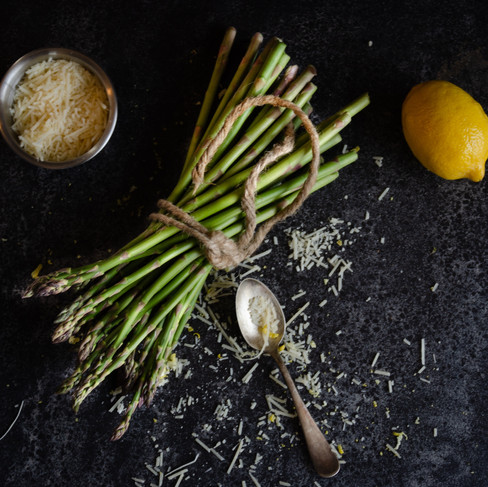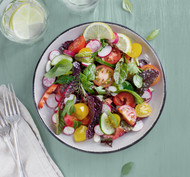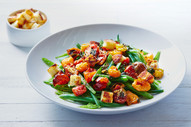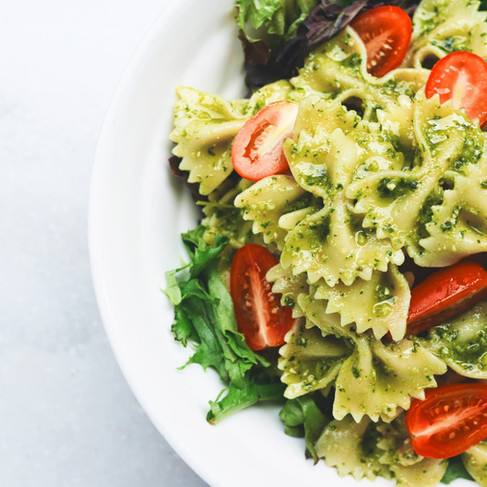Salads and Dressings
- Chef Savant

- Apr 16, 2020
- 5 min read
Updated: Jun 21, 2022

For many people, the word "salad’ carries the connotation of chopped lettuce, tossed or topped with carrots, tomatoes cucumbers, croutons, etc.. Others see salad as monotonous everyday lunch "affare", that just keeps getting boring, stale and old with each passing day. Still others find that getting children to eat salad can be a hard sell since, since, for some reason kids seem to grow up believing green foods simply aren’t meant to be eaten... To be fair when it comes to green vegetables, (and even some lettuces), they can have a bit of an earthy or bitter finish to them. Which has traumatized many of us, even as adults, to believe that if we eat from these earthy flavored green foods, we’re bound to continue having the ultimate bad flavor experience.
In truth, when it comes to salads, we don't have to be limited to just eating a head of lettuce, with the same ole salad dressing, and the same ole tomato/cucumber combination, from the same ole plate, for the same old flavors. There’s actually lots of little twists that we can do, to keep salads from being such a tired, and boring experience. For starters, we can season the salad lettuce, which most people never even think to do. We can also adjust the flavor of the salad dressings, even if we don't make them from scratch. So why don't we? Well in part, sometimes its just so much easier to just buy a pre made mix, and take it at face value. When we do this though, we often overlook the fact that, that perceived "value" has already been discounted by distributors that may be using inferior ingredients or who may have taken shortcuts by adding preservatives. And we get it, after a short night’s rest or a long day’s work, we’re just not in the mood to take a few extra minutes to think our way out of boredom, and so we settle for less than stellar combinations and fall into perpetual "salad monotony".
Avoid "Salad Monotony"
Simple steps like blanching vegetables,
adding a pinch of salt, a splash of acid, or pairing the them with other or complimentary flavors, can help mute less popular tastes and accent them for a more flavorful finish, without compromising the nutritional value.
Dressings can be just as simple...
A salad dressing doesn’t have to be overly complicated either. It can be something as simple as a drizzle of oil or made with as few as 2 ingredients. We’ve all heard of salads being dressed with only oil and vinegar right? But imagine what would happen if you added a little honey to that. Or maybe a little Dijon or Spicy Brown mustard. How about replacing the vinegar with lemon, lime, or orange juice. Want some thing less acidic? Try adding a dollop or your favorite yogurt or sour cream with a few well placed spices to the mix. Can you see how this is shaping up?
What if you wanted something that's a little less saucy and more hearty? Then a "soak" style dressing is a great way to achieve both with a wide range of bursting flavor combinations. Soak dressings are generally made by adding a few hearty ingredients like small diced fruits or vegetables, olives or capers, or roughly chopped fresh herbs, etc. to a basic vinaigrette. They work well with vegetable based salads, although in some instances they can also appear over the late panzanella/bread salads too. Want to go further? Feeling like trying something more advanced? Grab a blender and toss in your basic vinaigrette with some heavier ingredients like tomatoes, peaches, avocados, plums, pineapples, roasted peppers, etc... the list can go on and on. The concept is still the same; you add in your oils, your acids, your heavy stuff and little spice, give it a blend and you’re done.
The complex simplicity of salads is that, they can be made form a HUGE variety of ingredients and can fall into a wide range of categories. They can be eaten hot, or cold and can include... basically everything ranging from: lettuce, greens, fruit, grains, vegetables, chicken, steak, seafood, and again, the list can go on and on! In the spirit of tradition though, we’ll keep our focus simple and just highlight a few ways to help you put your signature spin on the salad styles of your choice.
For a more Crisp and Fresh textured salad...
In addition to greens and lettuces, other ingredients that support this category will be things like fruit, or blanched vegetables. Because of similar fiber structures these ingredients will work well together to fortify the texture of the salad giving it a nice "crunch" instead of a soggy bite. Complimentary dressings for this category usually default to vinaigrettes, but you can also get creative and add a little yogurt to your dressing for a creamy vinaigrette, or you could mix it up by adding a "soak" style dressing.
For Pasta and Grain based salads...
Aside from the obvious pastas and grains, complimentary textures for this salad category can be both crisp, and acidic. Because of the starches from the base ingredients (pasta/grains) this salad type not only plays well with acidic vinaigrette’s and soak dressings, but it can also hold up to creamier dressings like Caesar or Ranch.
In some cases you may want to create a contrast in texture by using fresh/crisp ingredients, (spinach, celery, sliced apples, or even toasted almonds) which can help keep the salad from becoming soggy or
"gummy" as it sits.
Protein based salads...
At times you may find a salad from either of these groups topped with additional protein. For example you may find a bed of fresh greens topped with, grilled steak/chicken, roasted salmon, or sautéed shrimp, etc. Conceptually this transforms the salad into more of a meal, instead of the afore mentioned day to day, old and boring conundrum. However there are other times when you may also see salads where the protein itself is the base ingredient; For example in a chicken salad, tuna salad, egg salad, shrimp or crab salad, etc. etc..

It most cases this style of salad defaults to the use of a more creamy dressing with less acidity; so again something like, mayo, yogurt, softened cream cheese, or sour cream. Because these are usually considered the heavier of the categories listed here, this type of salad often doubles as an entree, and is sometimes served as a topper over lettuce or on a sandwich
accompanied by fruit or chips.
Conclusion
In a nutshell, the biggest limitation to your salads/salad dressing is your imagination. Like any food type, its going to take a little trial and error to find what you like but you can do it! The easiest way to get going is to find the base type that you prefer, (lettuce, greens, grains, etc.) and begin adding other ingredients that you like. Try to think in terms of textures and flavors for your salad... Sweet and Sour... Fresh and Spicy... Crisp and Fruity. Etc etc, etc. We’ve listed a few flavor combinations below to get you thinking! These are NOT links, but as a suggestion, try using the first part of the salad "name" as your base. Use the 2nd part as the complimenting ingredients, and the final part as your "accent" to tie the first two parts together!
A few ideas to get you going...
Watermelon Cucumber Spice Salad w/ Fresh Mint and sweet Jalapeño dressing
Arugula and Peach Salad w/ Smoked Bacon and Cilantro Lime Vinaigrette
Wild Rice and Barley Salad w/ Fresh Herbs, Apricots and Grilled Chicken
Mandarin and Strawberry Salad w/ Pickled onions and Fresh Spinach
Roasted Chicken Salad w/ Greek Yogurt, dried Cherries, and Toasted Pecans
Grilled Romain w/ Caramelized Onions, Shaved Parmesan and Creamy Ranch
Tortellini Pasta w/ Fresh Basil, Shaved Prosciutto, and Roasted Tomato Vinaigrette
Drop us a line and let us know what you come up with!





























Comments